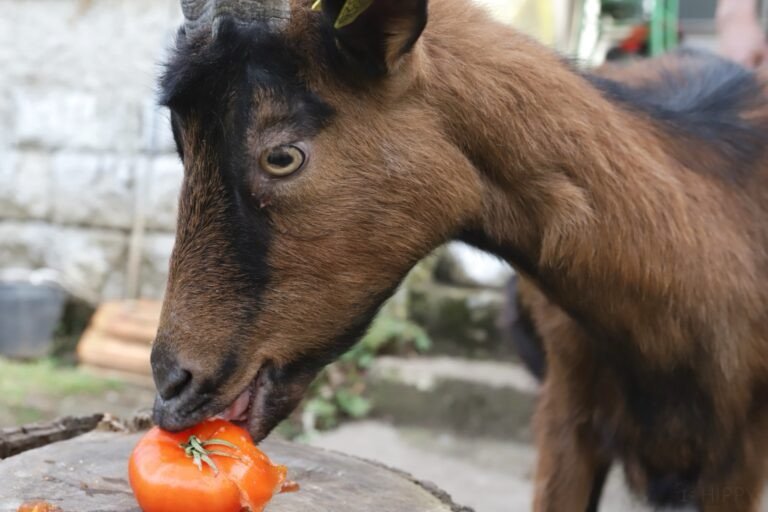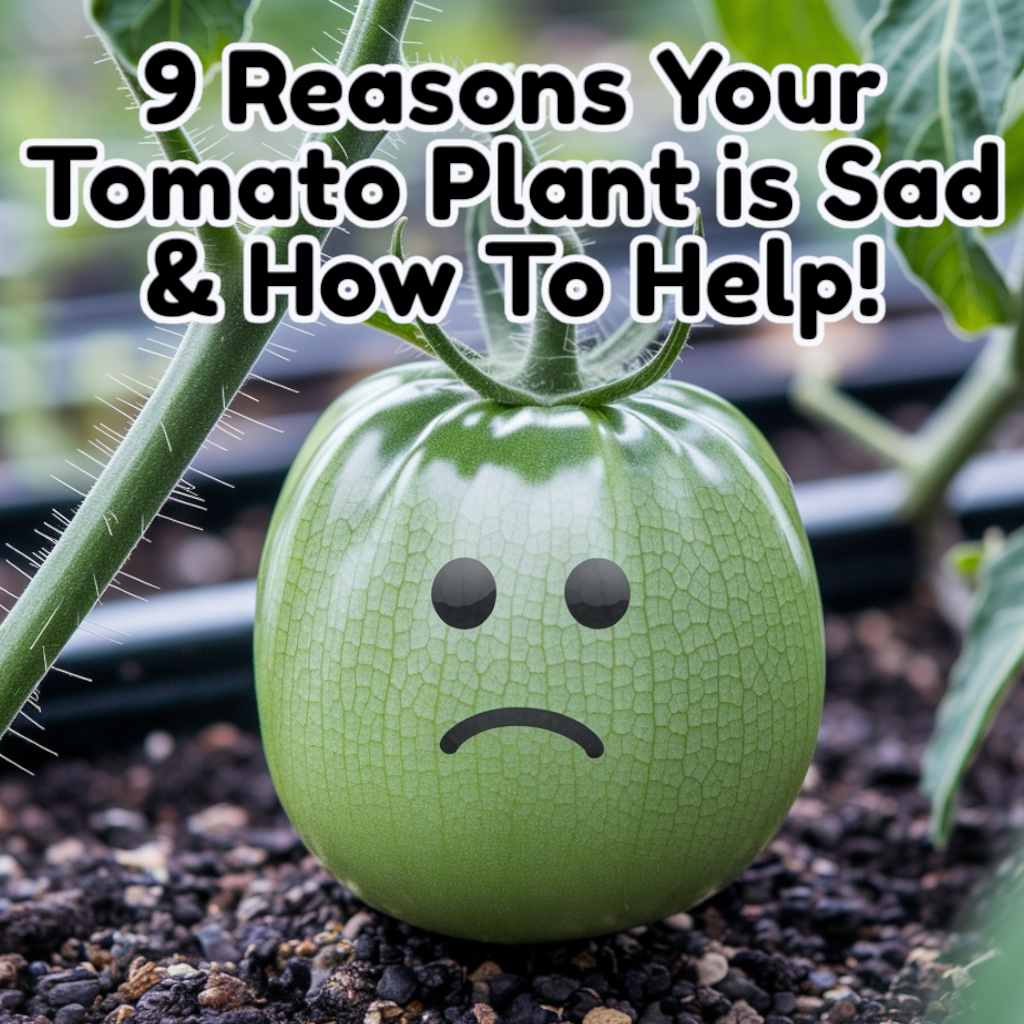
I Turned My Back for One Minute—And My Goat Ate a Tomato Plant
If you’ve got goats, you already know—you can’t turn your back for two seconds without them testing the limits of what’s edible. Mine had full access to a weedy patch near my tomato beds. I figured they’d stick to the clover. I was wrong.
I walked out with a bucket of water and saw one of my does casually chewing the stem off my San Marzano like it was a dandelion snack. Total goat move. My first thought? “She better not die, because that plant was about to fruit.” Second thought? “Wait… are tomato plants safe for goats?”
So I did what any panicked homesteader does—I Googled like crazy. And that’s how I found out this weird little overlap between goat foraging instincts and tomato plant toxicity. It’s one of those “you don’t know until your goat forces you to know” situations. Let’s break it down.
Can Goats Eat Tomato Plants Safely?
Let’s get this part out of the way: tomato plants are not goat food. They’re part of the nightshade family (Solanaceae), and the leaves, stems, and unripe green fruit contain tomatine, a compound that can irritate a goat’s digestive system—and in large amounts, it can be worse than that.
Here’s the thing though: goats are built to nibble and explore. One bite of a tomato leaf probably won’t do any lasting harm, especially if your goat is otherwise healthy and didn’t devour the whole plant. But regular access to tomato plants? Not a good idea.
Just because they can reach it doesn’t mean they should. And if your garden setup is anything like mine used to be, you’ll want to rethink what’s in reach. I figured out the hard way that goats will test anything once, especially if it’s green and nearby.
Also worth noting—plants that are already stressed or wilting can have even higher levels of tomatine, especially if the leaves are curling or yellowing. That’s something I covered more in this article about sad, stressed-out tomato plants, which can actually increase the risk if your goat decides to munch on them.

Are Ripe Tomatoes Safe for Goats?
Okay, here’s where it gets a little more forgiving: ripe, red tomatoes are usually safe for goats to eat in small amounts. I’ve given mine a few cherry tomatoes as treats and they were totally fine—no signs of discomfort, no drama, just tomato juice on their beards.
That said, I treat tomatoes like dessert. A slice here and there, not a regular part of their diet. Goats have sensitive rumens, and too much acidity or sugar from ripe fruit can lead to bloat, loose stools, or worse if you’re not careful.
It also depends on the tomato. If it’s overripe, fermenting, or starting to rot, I toss it in the compost instead. Not worth the risk of mold or gut trouble. I also make sure the fruit is fully ripe—green or half-ripe tomatoes are a different story (we’ll get to that).
When I do share a tomato or two with the herd, I only use fruit I’ve picked myself. Here’s how I know exactly when they’re ready so I don’t accidentally feed them something that could cause problems.
What Parts of the Tomato Plant Are Toxic to Goats?
This is the part I wish I had known before I ever let my goats roam close to the tomato bed. The most toxic parts of the plant include:
- Leaves – high in tomatine
- Stems – same deal
- Green tomatoes – still unripe = more tomatine
- Flowers – often overlooked, but can still irritate the gut
Even wilted or dried leaves carry the toxin. I used to think “oh it’s just a dead plant” so it’s fine—nope. Wilting actually concentrates tomatine as the water leaves the plant.
And unlike some animals, goats don’t always self-regulate when it comes to novelty greens. Especially young or bored goats—they’ll test anything, even if it doesn’t smell edible.
Now I treat my tomato plant zone as completely off-limits for goats, just like I would with things like rhubarb or azaleas. If they can reach over, they will. And one bored goat can chew through a season’s worth of tomato effort in ten minutes flat.

How Much Tomato Plant Is Dangerous?
Here’s the truth: a single bite of tomato leaf probably won’t hurt your goat. I’ve had a goat nibble off a leaf or two and suffer no obvious effects. But if your goat eats half the plant—or worse, several plants—you’re stepping into dangerous territory.
Tomatine is a dose-dependent toxin, meaning the more a goat consumes, the more likely they are to show symptoms like:
- Drooling
- Lethargy
- Diarrhea
- Weakness or trembling
It also depends on the goat’s size. A full-grown Nubian might handle a nibble better than a baby Nigerian Dwarf. If you suspect your goat got into more than just a few leaves, it’s better to call your vet early than wait and hope for the best.
The one time mine ate more than I realized, she was sluggish for a day, off her feed, and her poop got real loose. I kept her hydrated, gave her baking soda and hay, and stayed close—but I definitely wouldn’t want to repeat that experience.
Can Goats Eat Green Tomatoes?
Short answer? Nope. Don’t do it.
Green, unripe tomatoes have higher levels of tomatine than ripe red ones. That’s the plant’s natural defense system at work—trying to prevent animals from eating the fruit before it’s ready to grow seeds. Smart plant. Bad for goats.
I once tossed a handful of underripe cherry tomatoes into the compost pile (thinking I was being resourceful), and one of my goats helped herself. That was a fun 24 hours. She didn’t get seriously sick, but it was enough of a scare that I stopped using anything less than fully ripe fruit as feed.
If you’ve ever wondered when to pick tomatoes to avoid issues like this, I laid out exactly how I do it in that guide. Better for the tomatoes. Safer for the goats.

Signs of Tomato Plant Toxicity in Goats
So let’s say your goat got into your tomato patch. What should you watch for?
Here are some common tomato plant toxicity symptoms in goats:
- Drooling or excessive salivation
- Lethargy or unusual weakness
- Lack of appetite
- Stomach discomfort or bloating
- Trembling or muscle twitching
- Diarrhea
In mild cases, they might act a little off and bounce back in a few hours. In more serious cases—or if they’ve eaten a large amount—you should call a vet right away.
My rule is simple: if they act weird for more than a couple hours after eating something questionable, I’m calling for help. Goats go downhill fast if you don’t catch things early. Better to get scolded by the vet than lose a goat.
And of course, while you’re figuring things out, remove all tomato plants from their reach immediately. Goats have the memory of a goldfish when it comes to forbidden snacks—they’ll go back to the same spot tomorrow like it never happened.
How to Keep Goats Out of Your Tomato Patch
Here’s what finally worked for me: layered protection. Because goats are little garden ninjas. If they can lean, stretch, climb, or break something… they will.
These are the methods I now use:
- Raised garden beds – Like the ones I built in this metal raised bed article. They make it harder for goats to reach and easier for me to manage.
- Wire fencing around the garden area – Not just a pretty picket. I use livestock panels or welded wire.
- Keeping the tomato bed separate from their pasture – Even a few feet makes a difference. Goats are opportunistic but lazy.
- No climbing surfaces near the garden – If a goat can get a hoof on a bucket, stump, or rock, they’ll launch over your barrier like a mini acrobat.
I also stopped composting tomato vines where goats can get to them. That was an unintentional snack bar I didn’t know I’d created.

What to Feed Goats Instead of Tomatoes
Once I realized tomato plants weren’t a safe snack, I started looking for better options to keep my goats happy without risking their health (or my garden). Thankfully, goats love variety—and there are plenty of safer treats you can offer.
Here are some of my favorite goat-safe snacks that don’t cause me panic:
- Carrot tops and thin carrot slices
- Pumpkin guts and seeds (in moderation)
- Cucumber ends
- Apple slices (no seeds!)
- Banana peels
- Watermelon rinds
- Fresh herbs like mint or parsley
I always keep a small bucket in the kitchen during canning season and toss in the veggie scraps I know are goat-approved. They get a little treat, and I don’t have to worry about mystery symptoms showing up later.
Important tip: Just like tomatoes, keep these snacks as occasional treats, not a major part of their diet. Hay, minerals, and clean water are still the core of a healthy goat.
What I Do Now: Tomato Plants and Goats Don’t Mix
These days, I’ve got a hard rule at my place: goats don’t go near the tomatoes—ever. It took a few close calls and a couple of sick days to learn that lesson.
I keep my tomato beds fenced off and out of reach, and I compost old vines far away from their grazing area. If a tomato drops off the vine, I either grab it or toss it to the chickens (who don’t seem to mind a bit of red juice).
The goats? They still eye the plants like they’re forbidden candy—but they get their treats elsewhere now.
If you’ve got goats and tomatoes in the same backyard, it’s not the end of the world—but you do need a plan. One nibble probably won’t hurt, but don’t count on them knowing what’s good for them. And if they get into your tomato plants more than once, it’s time to put up a barrier and call it a hard no.
As an Amazon Associate we earn from qualifying purchases through some links in our articles.


